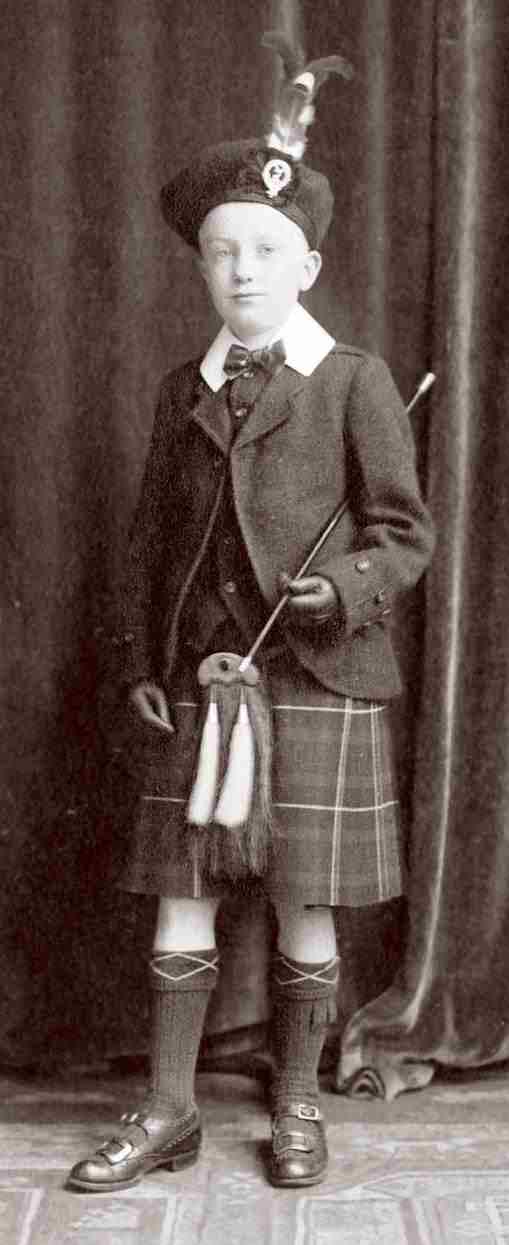
Scottish Kilts: Highland Kilt Outfits--Options

Figure 1.--This Scottish boy had his portrait taken with a formal Highland kilt outfit, in this case a three-piece outfit. Notice the military cuff styling. The only thing he seems to lack is a dirk in his knee socks. The image is undated, but we would guess about 1910. Image courtesy of the MD collection.
|
|
Proper Scottish kilts were a separate skirt-like garmet, usually in a tartan material. Boys and men might wear a full, formal Higland kilt outfit or they might wear a more informal outfit. A formal Highland kilt with all the regalia might consist of a Scotts' cap, prerably a Glengary, black jacket, ruffled jabot or Eton collar, kilt, trews, Argyle kneesocks, and broges or buckles shoes. Eton collars were common through the 1920s, but became increasinly less popular durng the 1930s. There were many variations, such as an eagle feather or dirk. Scottish boys wore both Barmoral and Glengary caps with theor kilts. Some fashion experts insist that the Balmoral should not be worn with the kilt. Scottish boys also wore much more informal outfits with kilts. A boy might wear a kilt with a tweed jacket to school or church. Until the 1920s this was almost always with an Eton collar. Eton collars were still common in the 1920s, but had become less so by the 30s. For casual after school activities he might wear his kilt with a warm sweater or other casual clothes.
Boys and men might wear a full, formal Highland kilt outfit or they might wear a more informal outfit. Proper Scottish kilts were a separate skirt-like garmet, usually in a tartan material worn with a range of different jackets. Boys and men might wear a full, formal Higland kilt outfit or they might wear a more informal outfit. A formal Highland kilt with all the regalia might consist of a Scotts' cap, preferably a Glengary, black military jacket, ruffled jabot or Eton collar, kilt, trews, knee socks (Argyl was a popular option), and broges or buckles shoes. Somewhat less informal outfits were worn with short jackets, often done in a light green or fawn tweed. Some of the regalia might be worn with either the black military or the short jackets, but the fanciest outfits such as the ones with lacy jabots were usually the ones with the black military jackets. While the jackets often varied considerablt, the accompanying kilts did not.
Informal Outfits
Scottish boys also wore much more informal outfits with kilts. For casual after school activities he might wear his kilt with a just a shirt or more likely a sweater. This might be the case in the Highlands wear kilts were more common than in the Lowlands. It also was more common in the 19th and early-20th century. After Woirld War I kilts gradually became less common for casual wear.
HBC

Navigate the Boys' Historical Clothing Web Site:
[Introduction]
[Activities]
[Biographies]
[Chronology]
[Clothing styles]
[Countries]
[Bibliographies]
[Contributions]
[Essays]
[FAQs]
[Glossaries]
[Images]
[Links]
[Registration]
[Tools]
[Boys' Clothing Home]
Navigate the Boys' Historical Clothing kilt pages:
[Return to the Main kilt page]
[Return to the Main Scottish kilt page]
[Return to the Main Scottish ethnic page]
[Kilt suits]
[Scottish boys clothing]
[Scottish school uniform]
[Highland dance]
[Scottish pipe band]
[Irish kilts]
[Irish boys clothing]
[Irish step dancing]
[Greek kilts]
Created: January 29, 2003
Last updated: 3:31 AM 1/16/2012



